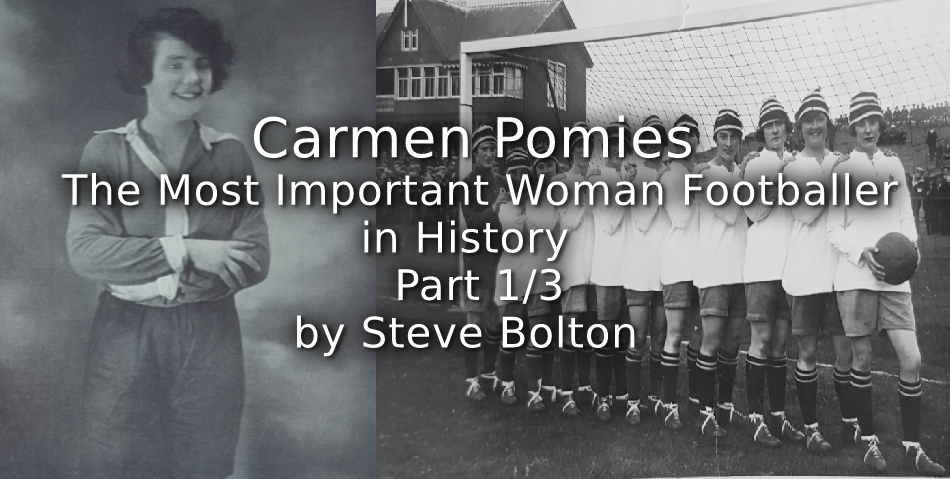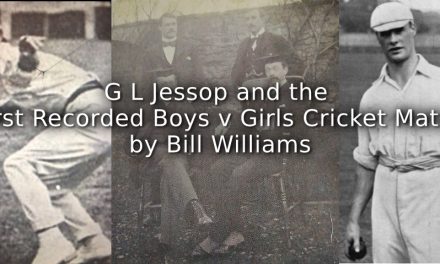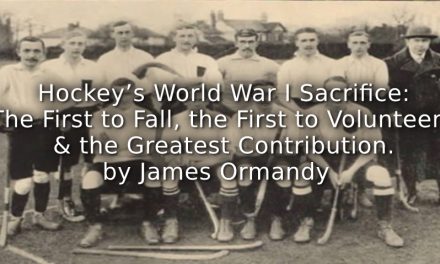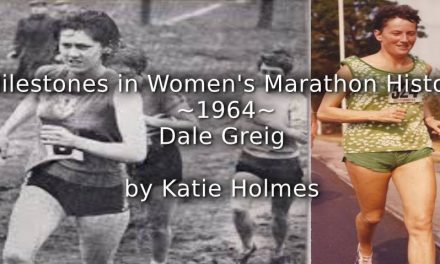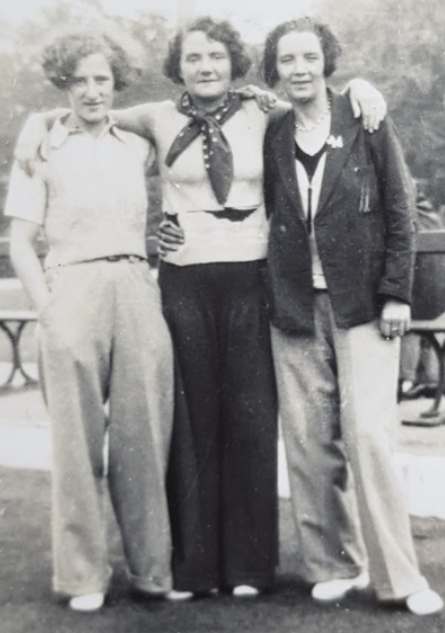
1934 Margaret Thornborough, Carmen Pomies, Lizzy Ashcrof
Source: Lizzy Ashcroft Collection
The Girl from Parr meets the Girl from Paris
Carmen Chantelle Marianne Pomies… 5 feet 8 inches of elegant muscle was an incredibly talented French woman. She was a superstar footballer in the golden days between World War 1 and World War 2. In my opinion there were three truly great teams in that era: Dick Kerr Ladies of Preston, Femina Sport of Paris and Rutherglen of Scotland. Incredibly, Carmen was a star in two of those teams. Feted and honoured in her beloved Preston and England I will be providing evidence of her crucial role in the history of women’s football. I will also pay tribute to someone whom I personally believe to be France’s greatest woman footballer: Madeleine “Mado” Bracquemond. It will not be possible in three short articles to do justice to the amazing lives of both women. My good friend Chris Rowe will shortly be publishing a book on Carmen’s life with the publisher Pen and Sword. Chris’ book is packed with fascinating contextual historical insights and has detailed research into the amazing Pomies family and their influential circle of friends. In my article I will be sharing some of the images from my collection of rare French Sports magazines and some unique images from the Lizzy Ashcroft Collection. In my three articles I hope to share some of the incredible story around the development of women’s football after the English FA ban of 1921 and Carmen’s central role. This story has not previously been told. In Part 1 I will develop the story of Carmen’s role in the 1920s and her leadership of the 1925 ‘Gallery of Champions’ tour which took place in the middle of the ‘wilderness years’. In Part 2 I will explore in detail the uniqueness and glamour of the 1925 tour. I will give a detailed analysis of this tour and the challenges faced by the women to play the game they loved four years after the English FA ban. Finally in Part 3 I will explain why there was a ‘renaissance’ of women’s football on these shores and that playing a key role in the renaissance was the incomparable Carmen. This is when she developed a close friendship with my granny Lizzy Ashcroft and from where our family’s unrivalled collection of photographs originate.
Preston Honours Carmen
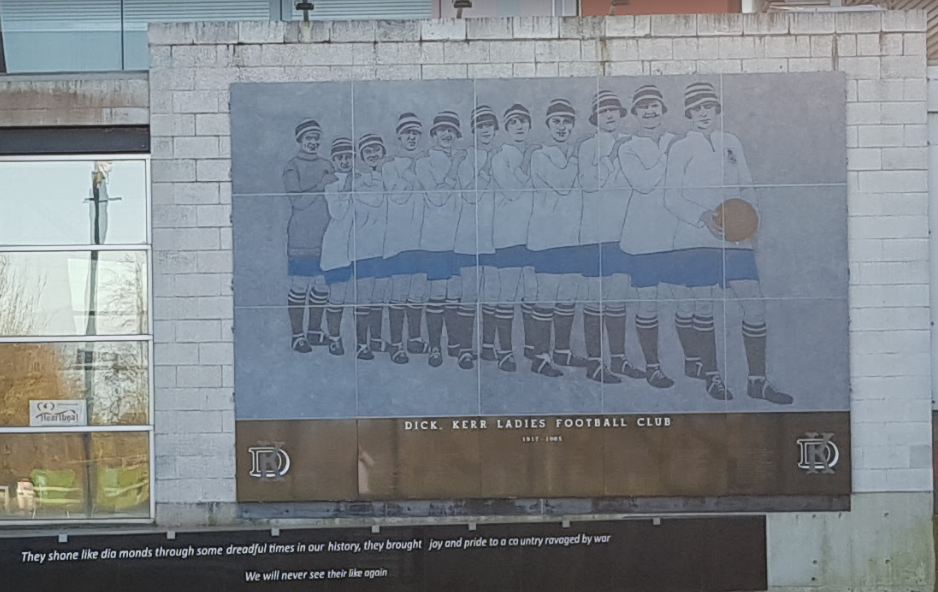
The DKL Deepdale Monument, Preston, Lancashire
Source: Author’s Collection
“They Shone Like Diamonds”
Situated at the mouth of the River Ribble, Preston is a post-industrial Lancashire town in the North West of England. Once rich and prosperous from the cotton industry it is beginning to prosper once again with its University and beautiful municipal buildings and parks. Preston was and always will be a ‘football’ town. Situated close to the town centre is Deepdale Stadium, the home of Preston Football. Facing across the car park from the stadium towards Moor Park is the 4 metre high granite monument to the ‘Dream’ Team. This is the 1921 Dick Kerr Ladies squad of invincibles who conquered America in 1922. Lily Parr is holding the ball. Holding onto Lily is the formidable Jessie Walmsley. Holding onto Jessie is Frenchwoman Carmen Pomies gazing out over her beloved Preston. In 1932 she was to play a key role on Moor Park in front of 10,000 Prestonians in a landmark 1930s game together with Lily Parr and granny Lizzy Ashcroft. Holding onto Carmen is the talented sprinter Alice Woods, followed by Florrie Haslam. Holding on to Florrie Haslam is another Florrie – the incomparable goal scoring machine Florrie Redford. Holding onto Florrie with her locks of hair attempting to break free is the legendary Dick Kerr Ladies Captain Alice Kell. Articulate and intelligent Alice was a respected Captain in the ‘Beckenbauer’ mould. Holding on to Alice is Daisy Clayton and then the team character – ‘the little box of tricks’ Jenny Harris – Lancaster’s star player who was imported into the Dick Kerr Ladies because she was so good. Emily Grice is the goalkeeper.
Carmen was a proud Frenchwoman who lustily sang the ‘Marseillaise’ and fought the gestapo with ‘all her heart’ during World War 2. How did the woman from privileged Montmartre of the ‘Belle Epoque’ end up being honoured with a bunch of working class girls from Northern Lancashire in such a way. It is an amazing story…
‘Acceptable’ Sports for Women…
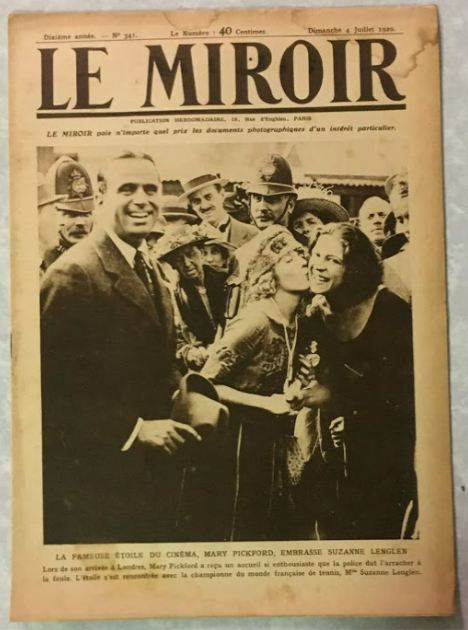
July 1920 Mary Pickford meets Suzanne Lenglen
Source: Lizzy Ashcroft Collection
Hockey, Tennis, Golf, Rowing, Skating, Walking – but NOT the ‘male’ sport of Football…
In the 1920s Mary Pickford “America’s Sweetheart” was a global superstar and celebrity. She was known as the “Queen of the Movies”. Suzanne Lenglen was not ‘just’ a tennis player. She was referred to in the press as ‘La Divine’ (‘The Goddess’). Her reputation even today is formidable with the second court at Roland Garros named in her honour. She was ranked as the inaugural world number 1 at tennis from 1921 to 1926. Suzanne had a balletic playing style and this together with her exuberant personality helped make her a national heroine in a country coping with the aftermath of World War 1. She revolutionised the sport by integrating the aggressive style of men’s tennis into the women’s game, breaking the convention of women competing in clothing unsuitable for tennis, and incorporating fashion into her matches. Suzanne Lenglen was not the only French woman revolutionising attitudes to women in sport in this era. Women had begun to break boundaries with the inclusion of women’s tennis and golf in the 1900 Olympics. In France a key event in 1912 was to have far reaching consequences to which the women and men of today owe a great deal…
1912: Femina Sport, Paris, France
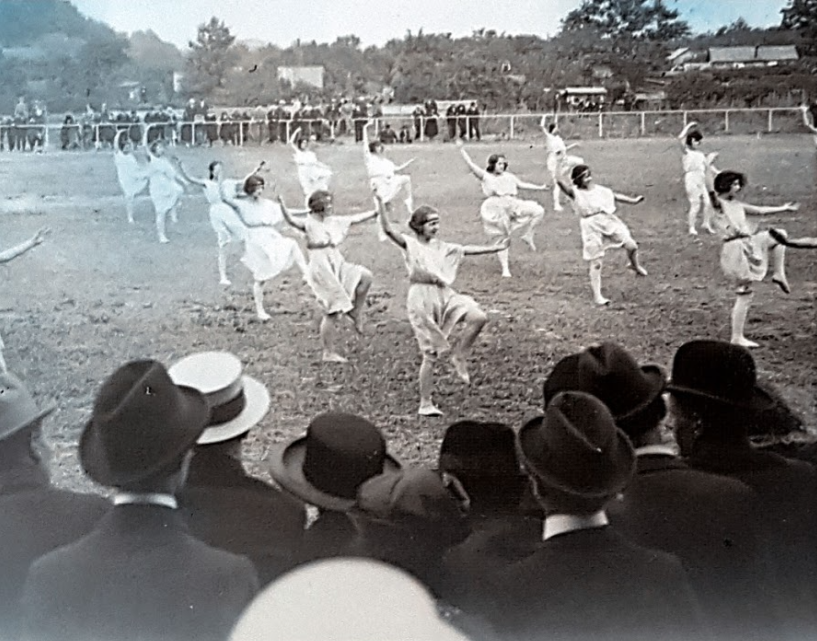
Femina Sport – French Interpretation of Ancient Hellenic Exercise and Rhythmic Movement
Source: Lizzy Ashcroft Collection
The Most Important Female Sporting Organisation in History
On 27 July 1912 Germaine Delapierre, Suzanne Liébrard and sisters Jeanne Brulé and Thérèse Brulé helped form Femina Sport. By 1925 there were reputed to be over 1,000 paid up female members and other similar organisations such as Academia, En Avant, Les Hirondelles and Les Sportives were thriving. Femina Sport even had its own stadium: Stade Elisabeth. Stade Elisabeth is located in the South of Paris near to the Porte D’Orleans and is still in existence today. In 1925 as well as a large covered stand the stadium had a shooting range, a gymnasium and a canteen. Jeanne Brule was an athlete who went on to become President of Femina Sport and General Secretary of the FSFSF (Fédération des Sociétés Féminines Sportives de France). She was awarded the Légion D’Honneur in recognition of her role in promoting women’s sport. However of particular interest in this story is her sister Thérèse who had a pivotal role in the development of women’s football.
The image above is not unusual. There was a ‘craze’ for dressing in very specific, ancient Greek style robes and attempting graceful, rhythmic movement. This exercise took place at women’s sports gatherings alongside traditional track + field athletics and in later years ‘basketball’ (a form of netball), football and barette (developed from rugby). Large numbers of women dressed in robes performing rhythmic exercise/ movement is an image seen in numerous photographs and newspaper and magazine articles of the time. Although this ‘craze’ appears to have started in Paris it spread around the country and I have a very similar image from 1927 which was taken just outside Lyon.
Paris: A Cultural Melting Pot
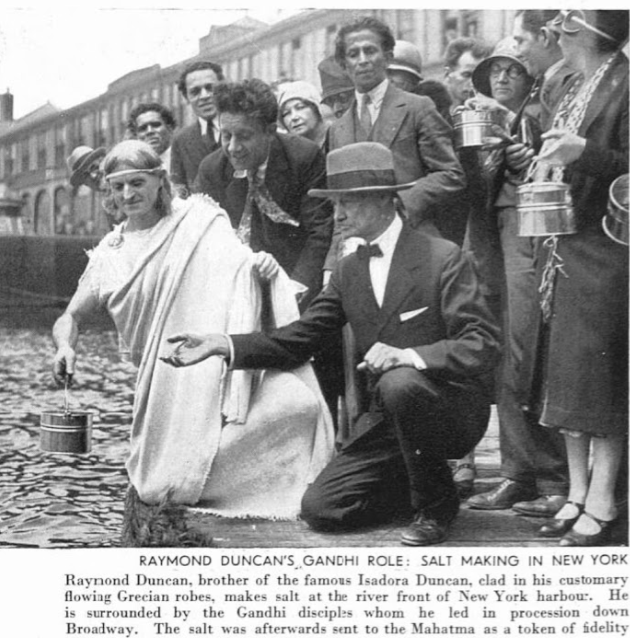
1930 Raymond Duncan making salt from the Hudson River
Source: BNA The Graphic Saturday 14 June 1930
A Hellenic Ideal
Raymond Duncan was the brother of dancer Isadora Duncan. He and his Greek wife Penelope developed an all encompassing philosophy of life which was based on their interpretation of an ancient Hellenic ideal. If you were to visit their original home in Greece then you had to change into robes and sandals to enter the house. By 1911 they were announcing their intention to set up a school of music, practical philosophy, ceramic art, weaving and a school of movement in Paris. As can be seen from the picture above Raymond was quite a celebrity with an eye for publicity.
1913 Ancient Grecian Dancing Revived in a French Forest
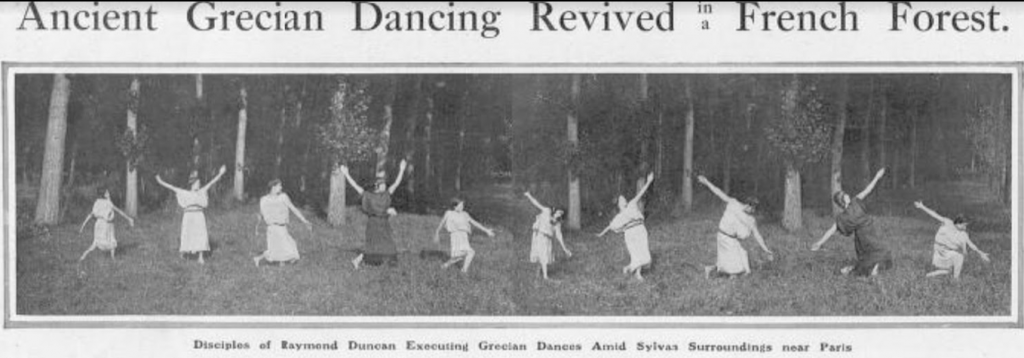
Village of Montfermeil, North of Paris
Source: BNA The Sphere Saturday 4 October 1913
Influenced by Images on Greek Friezes and Vases
Raymond Duncan was a very noticeable figure wandering around the streets of Paris prior to World War 1 dressed in Greek robes and sandals espousing a simpler way of life. His message of purity of body and mind would not be out of place today. In the heady mix of fin de siecle Paris his contribution to the melange of culture, ideas and exercise is remarkable. The actual movements were based upon studying the pictures on ancient friezes and vases and interpreting these into graceful movements. Hence we see the more traditional women’s sports, the traditional men’s sports and ‘gymnastique suédoise’ i.e. Hellenic-style rhythmic movement in robes developing together. ‘Gymnastique suédoise’ translates to english as ‘callisthenics’ but in this context is probably more akin to the Hellenic movement described above as it is to the modern idea of callisthenics.
This evidence generates the question around why these ultra-feminine exercises were developed. Were they simply popular or were they a way of off-setting criticism for participating in ‘masculine’ sports? This is, I think, an area for further academic research.
Thérèse Brulé: La Galerie des Champions
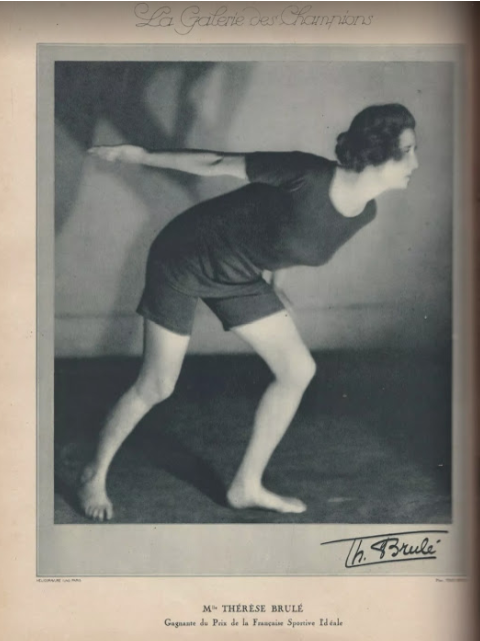
Thérèse Brulé featured in Tres Sport
Source: Lizzy Ashcroft Collection
1917: First Women’s Football Match in France
History was made at Stade Elisabeth, Paris on Sunday 30th September 1917. Twenty two women formed themselves into two teams of eleven and played the first women’s football match on French soil. The rather brief match reports simply record that the Thérèse Brulé XI (incl sister Jeanne) defeated the Suzanne Liébrard XI (incl Germaine Delapierre) by 2 goals to 0. By this point in 1917 both Suzanne and Thérèse were multi-talented athletes. Suzanne gave up football shortly after this but Thérèse continued with her football and featured in a number of important internationals. French women’s football took off from this first game and soon they felt able to challenge their famous counterparts across the Channel in Preston.
Madeleine ‘Mado’ Bracquemond: La Galerie des Champions
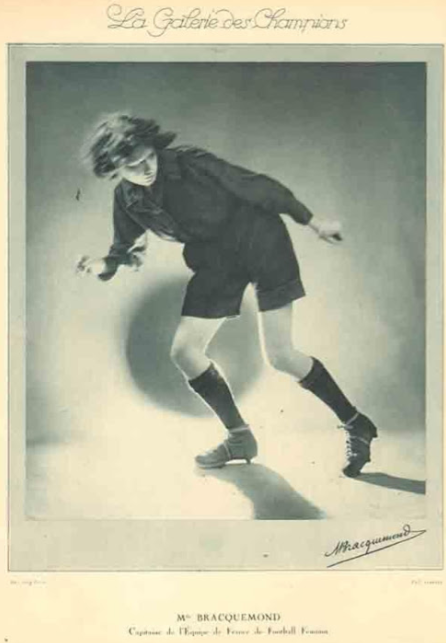
Mado featured in Tres Sport
Source: Lizzy Ashcroft Collection
1920: Carmen and Mado Tour Angleterre
The first ever foreign tour by a French women’s football team took place in 1920. The redoutable Alice Milliat organised the tour on behalf of the FSFSF (Fédération des Sociétés Féminines Sportives de France). The four game tour was played against the Dick Kerr Ladies with the following results:
Fri 30 April 2-1 win for DKL at Preston North End’s ground Deepdale – Crowd 22,000
Sat 1 May 5-2 win for DKL at Stockport – Crowd 15,000
Wed 5 May 1-1 draw at Hyde, Manchester – Crowd 3,000
Fri 6 May 2-1 win for France at Chelsea’s ground Stamford Bridge – Crowd 10,000
It was joy untold for the French team when they completed their tour with a win…
Carmen Pomies: La Galerie des Champions
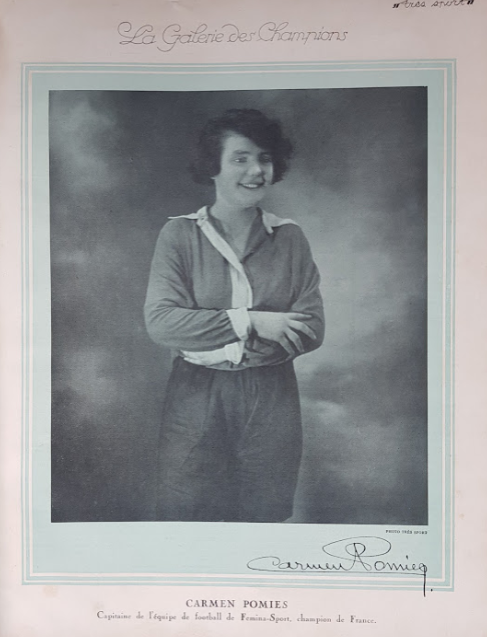
Carmen featured in Tres Sport
Source: Lizzy Ashcroft Collection
Blackpool – Je t’aime…
The French team was made up from a mixture of Femina and En Avant with one player from Les Sportives. Carmen is listed as full-back. Mado was the Captain of En Avant and assumed the Captaincy for the tour. Also in the team were Femina Sport founding members Germaine Delapierre, Jeanne and Thérèse Brulé.
As well as the usual receptions and tours where the games were hosted both teams were afforded a Civic Reception at Blackpool on Monday 3rd May. The teams were conveyed in two motor charabancs from the Bull and Royal Hotel in Preston. The charabancs were decorated with tricolours. They were entertained by the Mayor Councillor Eli Howe and a representative of the Ex-Soldier’s National Federation. After refreshments they were given a tour of the town which included visiting North Pier, the Tower, the King’s Convalescent Centre and the Winter Gardens where they had tea. This is probably where Carmen developed her love of Blackpool. When the French team arrived back at Gare du Nord in Paris a huge crowd greeted them with bouquets of flowers and Mado was carried through the station.
1920: Dick Kerr Ladies Tour France
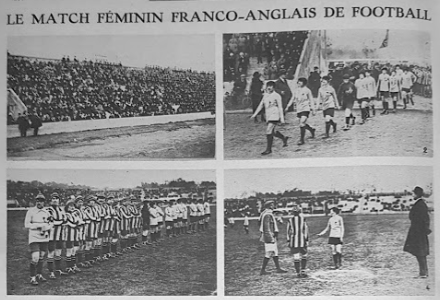
Le Miroir des Sports – Stade Pershing
Source: Lizzy Ashcroft Collection
1920: Carmen and Mado on Home Soil
Incredibly the Dick Kerr Ladies only toured on French soil twice. The second time was 15 years later in 1935 when my granny Lizzy Ashcroft led the tour. This 1920 four match tour was led by the legendary Alice Kell and included a raw, talented 15 year old full-back who had been recruited from St Helens – Lily Parr
Sun 31 Oct 1-1 draw at Stade Pershing, Paris – Crowd 22,000
Mon 1 Nov 2-0 loss to DKL at Parc Jean Dubrulle, Roubaix – Crowd 10,000
Sat 6 Nov 6-0 loss to DKL at Stade Cavee Verte – Crowd 6,000
Sun 7 Nov 2-0 loss to DKL at Stade Lilas, Rouen – Crowd 14,000
Mado was again the Captain. Carmen had now moved to right half.
Isle of Man: The Girl from Parr Meets the Girl from Paris
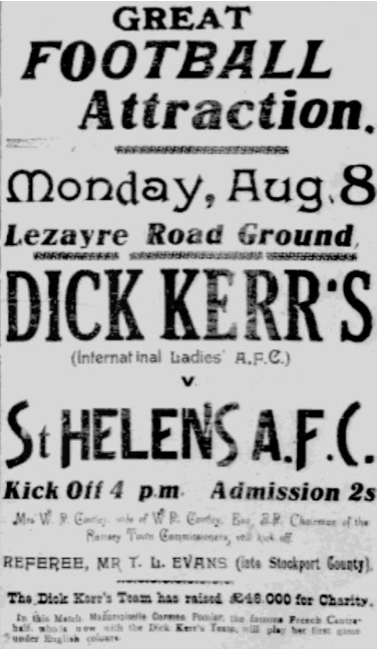
Isle of Man – Dick Kerr Ladies v St Helens
Source: IOM Newspaper Archive Ramsey Courier Friday 5 August
Carmen Pomies Debut for Dick Kerr Ladies
During August the superstars of the Dick Kerr Ladies took the young girls of St Helens AFC on a three game tour of the Isle of Man. My 16 year old granny Lizzy Ashcroft had only made her debut 4 months earlier for St Helens so I wonder how she must have felt to be on tour with the Dick Kerr football legends Alice Kell, Florrie Redford, Jenny Harris and Carmen Pomies. The plucky St Helens team lost all three matches but detailed match reports singled out Lizzy, Lydia Ackers and Susie Chorley for praise. It is no surprise then that 2 years later these three St Helens players went to have lengthy careers with the Dick Kerr Ladies.
On Carmen’s debut the Dick Kerr Ladies won by 5 v 3 in front of a reported crowd of 5,000 at the Lezayre Road Ground in Ramsey with a Florrie Redford hat-trick. The Isle of Man Examiner reported: “… superb half back play by Miss Woods (centre half) and Mademoiselle Carmen Pomies of Dick Kerrs and Miss Fairclough of St Helens.” Carmen had joined the ‘dream team’…
1921 August: Carmen Joins the ‘Dream Team’
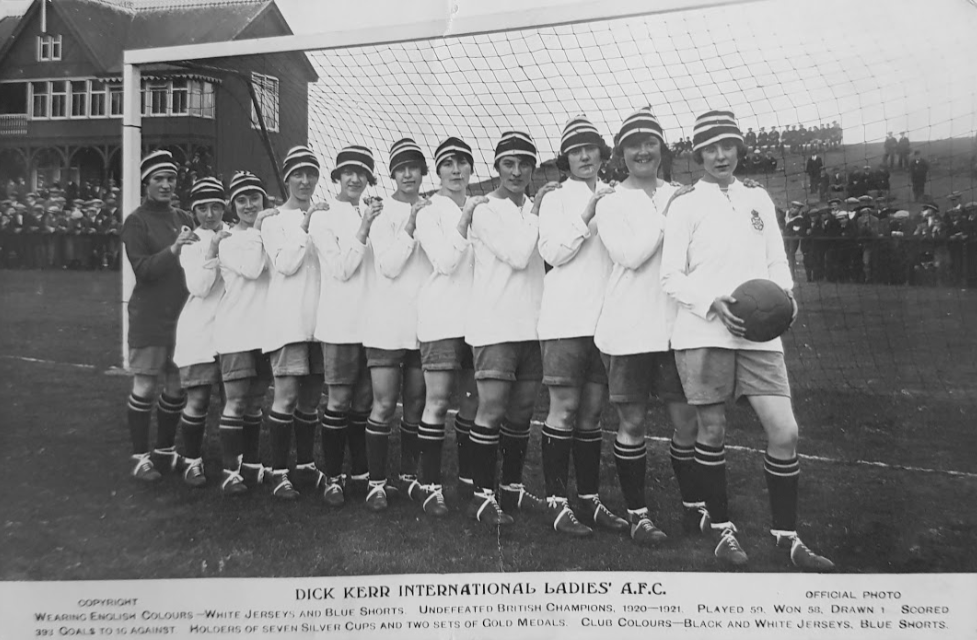
Postcard “DICK KERR INTERNATIONAL LADIES AFC”
Wearing English Colours – White Jerseys and Blue Shorts – Undefeated British Champions, 1920-1921
Played 59 Won 58 Drawn 1 Scored 393 Goals to 16 Against
Holders of Seven Silver Cups and Two Sets of Gold Medals
Club Colours-Black and White Jerseys, Blue Shorts
Lily Parr, Jessie Walmsley, Carmen Pomies, Alice Woods, Florrie Haslam
Florrie Redford, Alice Kell, Daisy Clayton, Jenny Harris, Emily Grice
Source: Lizzy Ashcroft Collection
Carmen Pomies: Dick Kerr Lady
In my opinion this is the greatest women’s football team in its greatest incarnation. Carmen is the third from the front on this ‘British Champions’ postcard which was used for the Deepdale Monument. The above is a copy of my signed postcard. Each of the team has signed in beautiful calligraphic script and described their position.
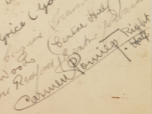
Carmen has signed herself “Carmen Pomies Right Half”. I would like to take this opportunity to publicly thank the ‘Red Rose Postcard Club’ for kindly letting me acquire this treasure. This postcard is now in the safe hands of the English National Football Museum in Manchester. This item will be going on display when the fabulous Lily Parr Gallery opens this year at the museum and is of course signed by Lily Parr herself…
Three Seasons of International Tours Involving English Clubs
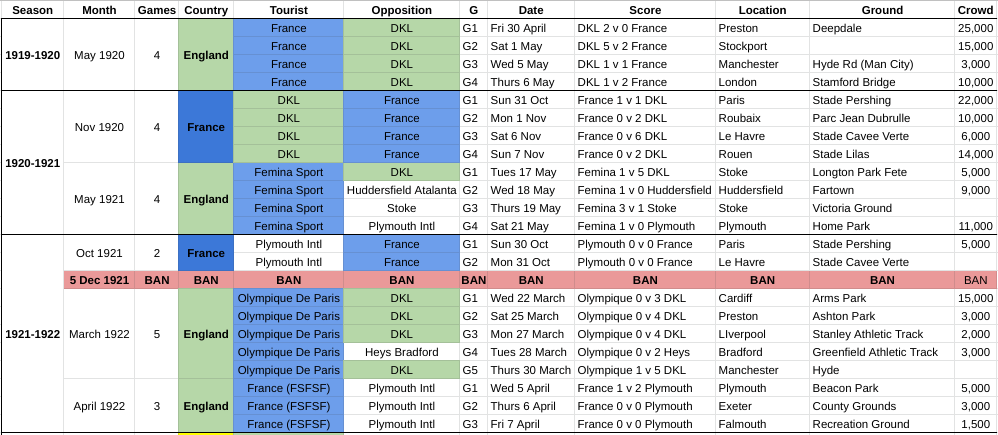
Key International Tours Involving English Clubs
Source: Author
Internationals Continue for Carmen and Mado
In May of the 1920-1921 season a largely Femina Sport based side toured. The Captain was still Madeleine Bracquemond and Carmen was still playing at right half. This tour was more successful winning all but their first game which they lost 5 – 1 to the Dick Kerr Ladies. The young left back Lily Parr had by now confidently moved to left wing and she scored all 5 goals.
In the 1922-1923 season there were two significant tours. In September/ October 1922 the Dick Kerr Ladies made their famous tour of America. In April of 1923 Heys Brewery Bradford played the French team in Stade Pershing and won a closely contested game by 1 goal to 0. The effects of the English FA Ban were beginning to be felt. In September of 1923 the Stoke Ladies played two games against Les Sportives in Barcelona.
1922: Goalkeeper Carmen Conquers America
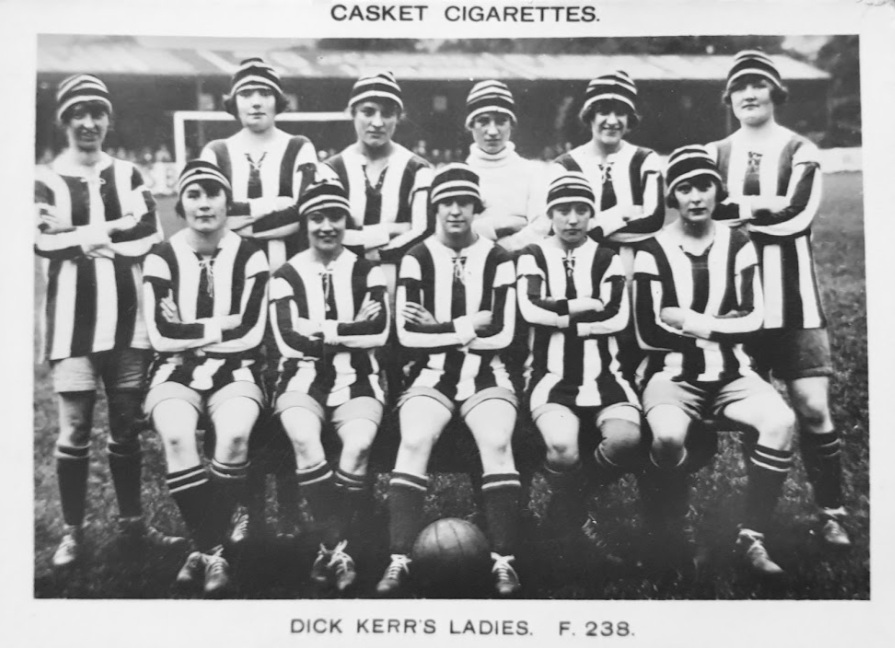
1921/22 Casket Cigarette Card
Standing: Daisy Clayton, Carmen Pomies, Alice Woods, Emily Grice, Alice Kell, Jessie Walmsley
Seated: Florrie Haslam, Jenny Harris, Florrie Redford, Alice Mills, Lily Parr
Source: Lizzy Ashcroft Collection
Dick Kerr Ladies Tour to America
The tour is covered in detail in Gail Newsham’s book: “In a League of Their Own”. This tour was absolutely unique and unprecedented. There are three main points that I would like to make for the purposes of this article. The first point is the coverage in the American newspapers. The culture in this country for ‘mixed’ (not DKL!) games of football was for the men to not try properly and sportingly let the ‘girls’ win. This was not the case in the US and the American newspaper articles make interesting reading as very little if any allowance is made for gender difference. The second point is this. In this incarnation of the Dick Kerr Ladies the goalkeeper often had very little to do because of the relative strength of the DKL to the opposition. This was not the case in America where Carmen performed a magnificent and very active role for her team in an unfamiliar position. The third point is that the Olympique de Paris tour and the two month American tour delayed the effects of the ban on the Dick Kerr Ladies. Carmen went back to France with Florrie Redford shortly after this tour and assumed the Captaincy of the legendary Femina Sport Football Team.
The Long Golden Age of French Football
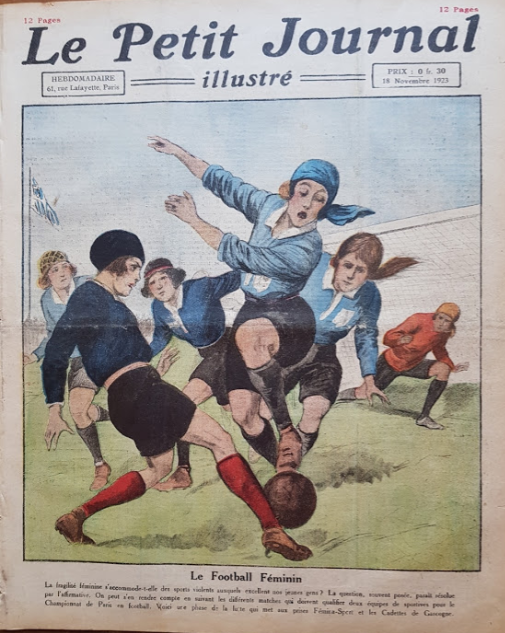
1923 Le Petit Journal – Femina Sport v Cadettes de Gascogne
Source: Lizzy Ashcroft Collection
Carmen & Mado & Violette…
It is not possible to do justice to the long golden age of French Football. Its highs, lows, controversies all make for a fascinating story. Carmen and Mado continued with their footballing exploits. Mado joined Femina Sport where Carmen had now assumed the Captaincy. Both of them continued with their other athletic exploits and won fame at international events. Another character who is worth a mention is Violette Gourard-Morris. Violette is easily the most controversial woman footballer in history. An extremely powerful woman, she became a hero in World War 1 for her driving skills and after World War 2 she was executed by the Maquis as one of the most reviled women in France. In between this she Captained Olympique de Paris and toured England in March 1922. She caused no end of trouble in French women’s football which wasn’t without its other scandals. Recent books have examined the evidence around her life in a less sensationalist manner and debunked some of the more extreme myths about her life. The expert on the French scene is Helge Faller and I highly recommend his website and books. Whilst women’s football in France flourished with tours to other countries, football on these islands was beginning to enter the ‘wilderness’ years thanks to the 5 December 1921 English FA Ban…
1921: English FA Ban
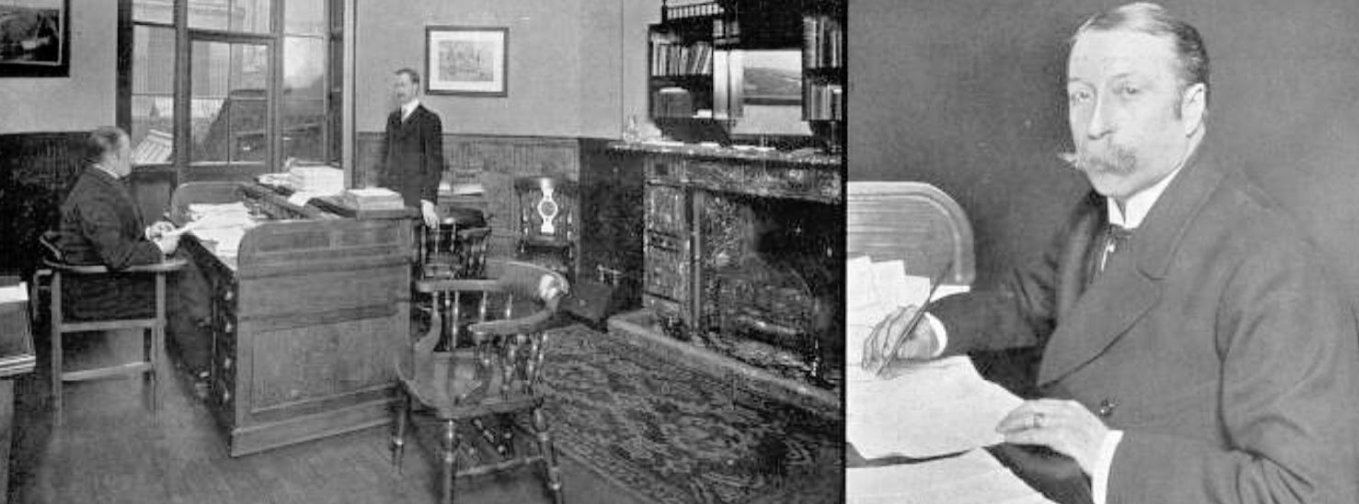
Frederick Joseph Wall – Secretary of Football Association, Russell Square Office, London
Source: BNA Illustrated Sporting and Dramatic News Saturday 6 April 1912
The Sword of Damocles Falls
It is not possible here to analyse in depth the many and complex reasons why I think that a ban happened or that it was inevitable. However, what is known is that at 3pm on Monday 5 December 1921 after a letter from ‘Major Cecil Kent’ had been read out in a rather short meeting at Russell Square the secretary Frederick Wall (later Sir Frederick) issued the infamous ban. The unfortunate phraseology of ‘women’s football is to be discouraged’ caused untold damage to the role of women in football and possibly other sports. It is worth looking at what kind of entity the English FA was at the time. In 1895 Frederick Wall took over as Secretary of the FA from Charles William Alcock who had held the position from 1870. Alcock’s family had a marine insurance business in the City of London. Wall held this position until 1934. Wall was a metropolitan lawyer. He entered football legislation in 1881 as a member of the London FA and he represented Middlesex on the Football Association Council from 1891 to 1895. He eventually became a director of Arsenal. In his 1935 auto-biography Sir Frederick actually mentions women’s football. He references the 1895 Crouch End game:
I was asked to referee the first women’s football match at Crouch End. I declined, but I went to see the match and came to the conclusion that the game was not suitable for them. Someone declared that one of the players was a ‘Tommy’ made up as a woman. The Football Association have discouraged this invasion of the ‘eternal feminine,’ just as they have discountenanced Sunday Football. Source: 50 Years of Football 1884 – 1934 Sir Frederick Wall
It is very interesting to notice that the man who signed off the ban on women’s football is referencing a game from 26 years earlier when the women were playing in long dresses, heavy work boots and what look remarkably like cricket pads… I think it would be safe to assume that his mind was made up prior to the meeting that no form of women’s football was to be acceptable on ‘male’ football pitches. There was a very noticeable metropolitan bias in the hierarchy of football. This is also very interesting to note when the many newspaper reports about the ban are analysed. The effect on women’s football was devastating. However despite numerous incorrect books and articles a great deal of women’s football did take place especially in the 1930s.
Cecil Kent is a very interesting figure. He is the one man of influence whose letter is actually read out at the ban meeting. He also organised the 1925 ‘Gallery of Champions Tour’. So who was Cecil Kent?
Cecil Kent of Westminster School
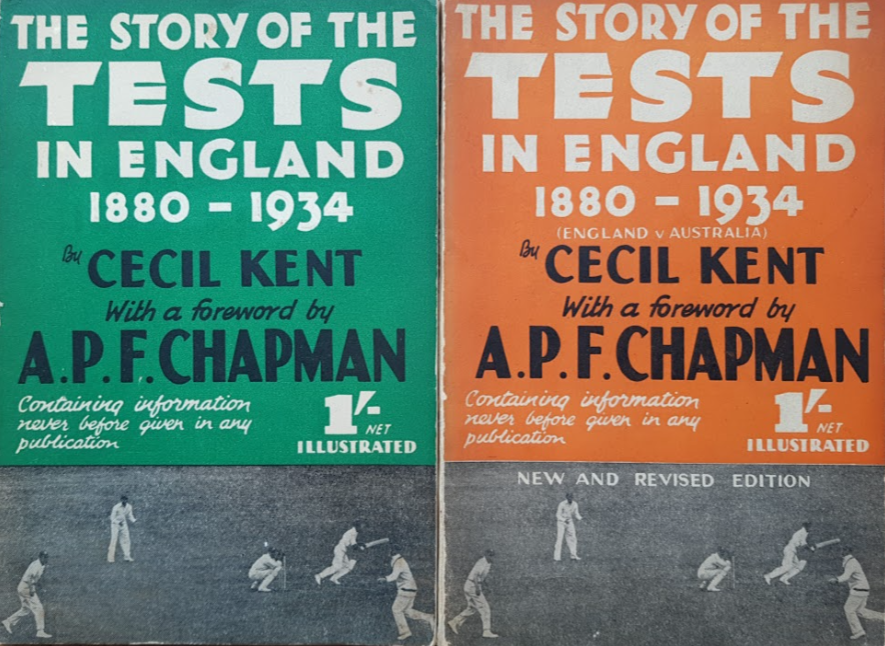
Cecil Kent – Author
Source: Lizzy Ashcroft Collection
Cecil Kent: Key Supporter of Women’s Football
Cecil Kent was born in 1883 in St Johns Wood, London. His father Charles was the Principal Secretary of Trinity House and his Uncle was Fleet Paymaster George Kent RN. His sister was Miss Irene Helen Kent who was second in command of Portsmouth WRNS. She was also founder and commander of “C” Company, Group 41 of the ATS. The young Cecil Kent attended Westminster School. Unfortunately his father lost his life by falling from the roof of Trinity House in 1902. Cecil attended Trinity College Cambridge where he joined the rowing club. A number of sporting reports with his name appear from 1908 to 1914 in Sporting Life and similar papers. This is either in Rowing, Football or Cricket for ‘Old Westminsters’. In 1909 he is credited with a large part in the formation of ‘Old Westminsters Boat Club’. He is also credited with opening the “400” club which was a forerunner to the ‘Embassy Club” on Bond Street. During WW1 he is recorded as being ‘Lieutenant Commander Royal Navy Volunteer Reserve’. He next appears in 1921 organising and supporting women’s football in Liverpool where he is described as Major Cecil Kent of Liverpool. In 1925 strong evidence indicates that he organised the ‘Gallery of Champions’ tour. By 1934 he appears to have retired back to Southsea to live with his sister where he authored a book on cricket called: “The Story of the Tests in England 1880 – 1934”. Research is still ongoing as to his entitlement to the honorific Major. He passed away quietly after a long illness during WW2 and was buried in the family plot in Hampstead.
Cecil Kent: Women’s Football Organiser
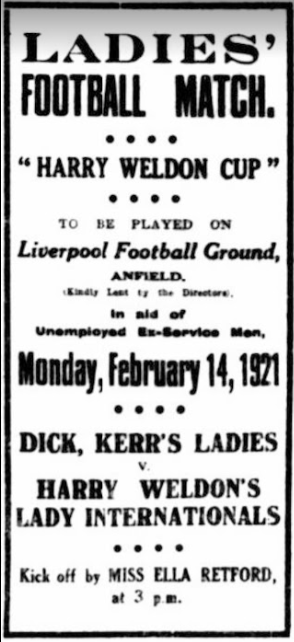
1921 Anfield – Dick Kerr Ladies 9 v 1
Harry Wheldon’s Internationals
On Monday 14th February 1921 one of the famous games of the Dick Kerr Ladies took place in Liverpool. Harry Wheldon the music-hall comedian was appearing in Dick Whittington at the Olympia in Liverpool with Ella Retford. A Charity Costume Carnival, 1 ½ mile Procession and a Ladies football match were organised. The procession left Olympia at noon and proceeded along to Anfield where the football game took place. The International team was made up of players from as far afield as London and Scotland. The ‘Internationals’ team was captained by Edith Waine the famous St Helens goalkeeper and my granny’s first Captain. 14,000 spectators saw the game and a lot of money was raised for unemployed ex-servicemen. Along with Harry Wheldon, a ‘Major Cecil Kent of Liverpool’ is credited with being one of the organisers.
Cecil Kent’s Letter: 5 December 1921
“Are Their Feet heavier on the Turf than the Men’s Feet?”
Dear Mr Frederick Wall – FA Secretary
I may mention that in the present and past seasons I have watched about 30 ladies football matches between various teams. I have met all the organisers of the teams and all the girls in the elevens; I have travelled with them frequently by road and rail; I have attended the various functions to which they have been invited and have met Lord Mayors and Mayors and also the officials of the local charities and football clubs concerned.
On all hands I have heard nothing but praise for the good work the girls are doing and the high standard of their play. The only thing I now hear from the man in the street is, Why have the F.A. got their knife into girls’ football? What have the girls done except to raise large sums for charity and to play the game? Are their feet heavier on the turf than the men’s feet?
The girls of the Dick, Kerr’s team are all workers, who, when they are away playing football, draw from their “gates” the equivalent of their loss of time – generally not more than 10 shillings each for a whole day.
Regarding their entertainment to lunch and tea, Major Kent says that
… they are often given an insufficient meal and something in the nature of a sacred concert instead of a jazz dance, while invariably they are regaled with a dozen long and more or less dull speeches by the local mutual admiration society, who in every town say almost the same thing until ‘bored stiff’ represents the girls’ feelings.
Major Kent points out there are many reasons that their expenses sometimes appear a trifle high. Firstly a girls’ team, for considerations of health, must carry more reserves than are necessary for men’s clubs. Secondly, when arriving home by train late at night or in the early hours of the morning, taxis must be hired to take girls home to outlying districts.
I can only say that I know that no unnecessary expenses are ever charged by the reputable girls football clubs, and that the charities alone benefit from the matches.
Hitherto the F.A. have made no attempt to control girls’ football, but if they only legislate the girls’ clubs will accept their regulations cheerfully and abide by them faithfully. The excellent behaviour and obedience of the girls on the field of play is a sufficient indication of that, and I am sure Mr Howcroft or any of the other leading referees who have controlled games will testify to this.
Before your council takes any drastic or final step on this important matter I sincerely hope that they will seriously consider the question of legislating for ladies’ football and that in any case they will refrain from debarring the girls from using their grounds when available. Such a ban would raise two main points.
Firstly, by act of the F.A., every Lord Mayor, Mayor, unemployed fund, hospital, and other charity in England would be deliberately deprived of what is now a little gold-mine to them. I am quite aware that the F.A. Charity matches annually raise about £20,000, but the girls supplement to this of £100,000 in two years can hardly be ignored.
Secondly, a little gratitude is undoubtedly due to the girls themselves for all they have done and are willing to continue to do. The greatest reward that can be given to them by the F.A. is to be allowed to go on playing the game. That is all they ask. For football they have given up other amusements and other forms of sport, although in many cases lack of means and opportunity do not grant them much choice of the latter. Many of the girls have now played continuously, winter and summer, for four years, and they have become confirmed footballers.
Wilfully to deprive them now of the game they love would be far worse than to pass an Act of Parliament forbidding all confirmed golfers ever to set foot on a golf course again. For one thing, golf is a selfish game, whereas girls’ football is utterly unselfish and supremely useful.
Yours sincerely
Cecil Kent
Author’s Note
This is my first attempt to reconstruct the letter from 100 years ago. The letter was heavily quoted in a number of newspapers.
The ‘Wilderness Years’
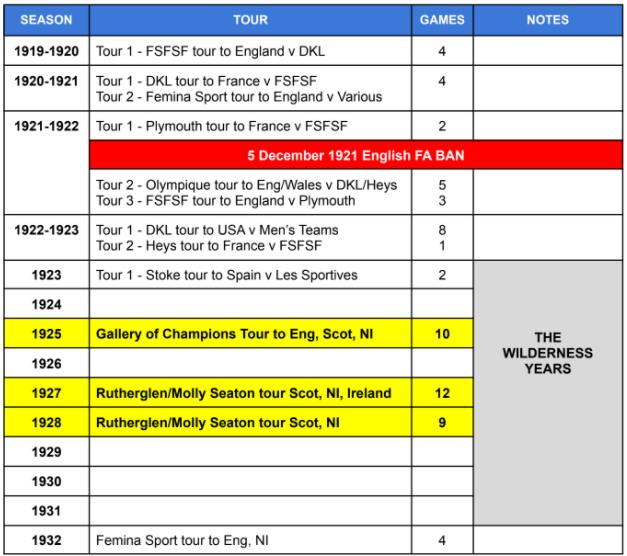
1925: A Puzzling Tour
The 1925 Gallery of Champions Tour is a puzzle. It is an outlier. It is not built upon a meteoric rise in support for women’s football. Quite the opposite. The Dick Kerr Ladies lost three times in 1923. Shortly after the 1922 American tour Carmen returned to France accompanied by her good friend Florrie Redford. Jenny Harris joined Heys Brewery Bradford Ladies. They had lost three of their superstars. In March 1923 the DKL lost 3 v 1 to St Helens and in September 1923 they lost twice. Rutherglen beat them 2 v 0 in Glasgow and Stoke (in their last game) beat them 1 – 0 at Colne Cricket Club. The great Daisy Bates sprinted half the length of the pitch and blasted one in. The DKL lost a lot of money on the two floodlight games at Turf Moor against Heys at the end of 1923. They had all sorts of plans for 1924 such as touring Ireland but nothing came off. In Parts 2 and 3 I will have more to say about the ‘Wilderness Years’ and the ‘Renaissance’ of the 1930s. As indicated in the table above it wasn’t until 1932 that the French under Carmen Pomies were to tour again and although this was an incredibly important tour it was only for 4 games and only 2 of these were in England.
1925:Carmen & the Gallery of Champions
Greeted by Three Admirals and a Major General
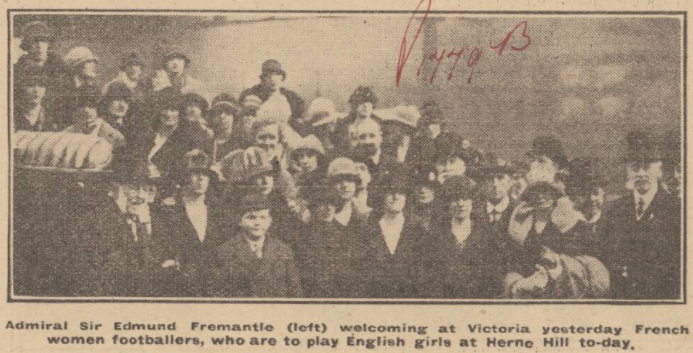
Victoria Station, London
Source: BNA Daily Mirror Monday 11 May
An Excited Carmen Outlines The Plan
The afternoon of Sunday 10th May 1925 found 88 year old Rear Admiral Sir Edmund R Freemantle (known as ‘the father of the navy’), Rear Admiral Alfred Grant, Vice-Admiral Sir Drury Wake and Major General Lorn Campbell standing on the concourse of Victoria Rail Station in London. In the welcoming party was the organiser of the tour Cecil Kent and the visiting secretary of Shipwrecked Mariners Society Captain Fred Haworth. Also waiting were a team of excited Lancashire lasses and their manager Alfred Frankland. The objects of this unique honour were one of the greatest women’s football teams to ever leave the shores of France. The 12 strong tour party was managed by the distinguished and respected Sports Administrator Eugene Janvier. Monsieur Janvier was a runner and distance walker prior to World War 1 and needed a stick to walk because of his tin leg. The team of footballers had been selected from the 6 Femina Sports Football Teams and included 4 Gallery of Champions Players: Captain Carmen Pomies, Mado, Thérèse Brulé (now Madame Herckelbout) and athletic Catalan goalkeeper Ida Rebardy. Carmen was interviewed in the Bonnington Hotel on Southampton Row, London where the teams were staying for Sunday night. “Tomorrow we are all going to be received by the Lord Mayor of London at the Mansion House, then we are going to see your wonderful Wembley, and after that we are going to have tea on the Terrace at Westminster”. “We are very proud of that distinction and we hope the members of Parliament will like us! Yes! Then we are going to play football”. To my knowledge no other women’s football team in the history of football has been honoured with an invitation to Parliament. My granny was 20 years old…
1925: Guests of Lord Mayor of London

Lord Mayor of London – Sir Alfred Louis Bower
Source: BNA Illustrated London News Saturday 4 October
Received at Mansion House by the Lord Mayor
Upon waking up and checking out of their hotel the teams would have had a two mile taxi ride to Mansion House in the City of London. Performing the role of host was 1st Baronet of Chislehurst the vintner Sir Alfred Louis Bower, Lord Mayor of London. This was not the first time the Dick Kerr Ladies or their visitors were honoured in such a manner. In May of 1920 on the inaugural tour Carmen and Mado had been guests of the then Lord Mayor with the Dick Kerr Ladies after defeating them at Stamford Bridge, Chelsea. The Olympique de Paris team were also honoured with a visit to Mansion House in March 1922. After their visit to Mansion House the teams headed towards the Houses of Parliament for their date with destiny. Unfortunately, I don’t think that Carmen got her chance to see ‘wonderful Wembley’.
1925: Sir Jack Benn Brunel Cohen KBE – A Truly Great Man…

Major Sir Jack Benn Brunel Cohen – Autobiography
Source: Lizzy Ashcroft Collection
Femina Sport And Dick Kerr Ladies Guests at Houses of Parliament
After their visit to Mansion House another 2 ½ mile taxi ride took both teams to the Houses of Parliament in Westminster. Liverpool Fairfield MP Sir Jack Benn Cohen was hosting them to tea on the House of Commons Terrace. Jack Cohen was the son of a well to do family in Liverpool. He married and when World War 1 came like a lot of his generation he volunteered. Injured in the third battle of Ypres on 31st July 1917 he had both legs amputated.

Source: Count Your Blessings – Sir Brunel Cohen KBE
His courage and spirit in the face of adversity allowed him to launch a civilian career which took him to the House of Commons for 13 years. He was a moving spirit and founder of the British Legion having badge number 5 and being their Honorary Treasurer for 25 years. He relentlessly fought for the rights of ex-servicemen, injured servicemen and for their memory. When there were serious plans in the early 1920s by the government to dilute the activities around Remembrance Day (I found this hard to believe when I read it…) he added his powerful voice to the campaign to maintain Remembrance Day as an important part of the national calendar. He travelled all around Europe and was a strong advocate of rapprochement after World War 1 between the former enemy nations for which he was not always popular.
1925: Gallery of Champions Tour – 10 Games

Femina Sport Club of Paris
Mado (4th left), Ida (7th left), Carmen (right)
Source: Lizzy Ashcroft Collection

Dick Kerr Ladies ‘World Champions’
Lily Parr (holding ball), Lizzy Ashcroft (next)
Source: Lizzy Ashcroft Collection
1925: Herne Hill Velodrome
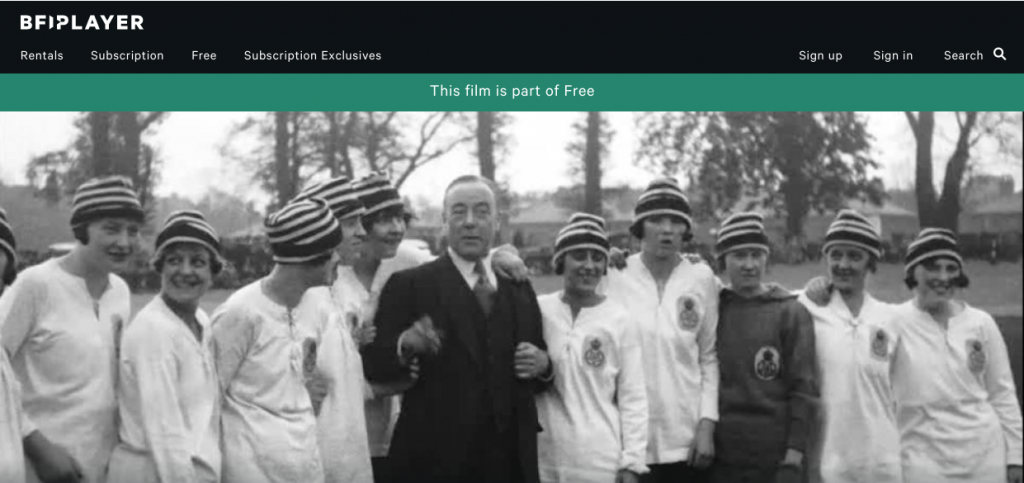
Dick Kerr Ladies with Celebrity Comedian George Robey
“BFI Fair Footballers”
Source: Courtesy British Film Institute
The Lilies of England Defeat the Lilies of France…
It is my opinion that this is one of the most important football games in the history of women’s football. Images and film from this game went all around the world and are still doing so nearly 100 years later. In the simple graphic which I shared earlier I began to define the context of the ‘wilderness years’ where this game took place. My 5 foot 8 inch granny can be seen standing next to the goalkeeper and her great friend the incredible Lily Parr can be seen with her arm around George listening to his words of wisdom. This beautiful and high quality clip of film shows the DKL Captain Florrie Redford running out with the ball from the Stadium Tunnel followed by Lily Parr and then by granny Lizzy Ashcroft. George Robey then lines up with the ladies followed by Captains Carmen and Florrie Redford shaking hands. We then see George at the kick off with three legends of French football – Carmen Pomies, Madeleine ‘Mado’ Bracquemond and Germaine Thomas. There then follows a Lily Parr dribble followed by a RIGHT foot shot – like a semi-inebriated grizzly bear wandering around the pitch and very reminiscent of Chris Waddle. We then see Carmen pole-axe the DKL goalie (goalies had a lot less protection in those days!!) and my granny remonstrate with Carmen. There are other clips available on British Pathe.
The game was won by 4 goals to 2 in favour of the Dick Kerr Ladies. Lily Parr scored 2, Lily Lee and Lily Buxton one each. The two Femina goals were scored by Carmen Pomies.
Ida Rebardy: La Galerie des Champions

Ida featured in Tres Sport
Source: Lizzy Ashcroft Collection
1925: The Gallery of Champions Tour
This touring team from France was a very, very special gathering of athletes. Galerie des Champions Thérèse Brulé (Mme Herckelbout), Madeleine ‘Mado’ Bracquemond and Carmen Pomies were joined by another ‘Galerie of Champions’ athlete and footballer, the Catalan goalkeeper Ida Rebardy. Ida was making her debut on English soil and she was kept very busy by a very strong Dick Kerr Ladies side. Remember, players like my granny and Lily Parr were aged 20 and must have been at the height of their footballing powers.
A Kiss is Just a Kiss?

Carmen Pomies and Florrie Redford
Source: BNA The Sphere Saturday 16 May 1925 p6
Carmen and Florrie Were Very Good Friends…
The proverbial ‘kitchen sink’ was thrown at this game. The teams were filmed and photographed. Both teams had exploited the power of the kiss as an image previously. When the Dick Kerr Ladies played the FSFSF French team on 1st May 1920 at Stockport, Captains Alice Kell and Madeleine Bracquemond posed for a kiss. The Stockport kiss was one of a number of staged photographs taken before the game. The Carmen/Florrie kiss was a very knowing kiss between two very intimate friends and the image was repeated all over the world. They knew exactly what they were doing. The image was widely used in the British and French press with newspapers such as the national Daily Mirror, the London publication The Sphere and the Leeds Mercury all printing. Argentinian magazine El Grafico printed the image on the front page of its June issue. The image was repeated in a number of American newspapers as far and wide as the Minneapolis Star and the Saskatchewan Leader Post. Even the normally conservative Dublin Herald showed the picture. Women in shorts – and they are kissing! I have stated in a previous article where I tried to debunk some of the more ridiculous myths around my granny’s great friend Lily Parr that Lily and her ilk were extremely private women. Florrie and Carmen by contrast were confident extroverts. I will explore this tour in detail in Part 2. The other team claiming to be ‘World Champions’ at the time were from Scotland…
1927: A Historic Tour – ‘Scotland’ vs ‘Ireland’

‘Scotland’ – Rutherglen/ J H Kelly XI in Derry in May 1927
Source: Bigger McDonald Collection

‘Ireland’ – Molly Seaton XI in Derry in May 1927
Source: Bigger McDonald Collection
1927: A Remarkable Tour
James H Kelly of Rutherglen, near Glasgow did not have a ‘Galerie des Champions’ French team to tour with. He did not have a Cecil Kent to organise the tour with the assistance of Captain Haworth of the Shipwrecked Mariners Society. It is important to understand just how significant and unique this particular tour was. The next high profile tour not involving Rutherglen on these islands was when Femina Sport toured England with the Dick Kerr Ladies (Preston Ladies) in 1932. Neither the Dick Kerr Ladies nor Femina Sport were able to achieve their long held aim of playing in Dublin but J H Kelly achieved this on this unique tour. The importance of ‘seeding’ the 1930s renaissance of women’s football in Northern Ireland cannot be underestimated. The fabulous J. H Kelly gave us his two star footballers: the legendary Molly Seaton, Belfast’s finest footballer and Sadie Smith, the superstar of Rutherglen. I have written a detailed two part article covering initial research into this incredibly important team and Inter-War Scottish Women’s football with Dr Fiona Skillen of Glasgow Caledonian University. The articles are published on Playing Pasts (Reference and links at the end of this article).
Conclusion to Part 1
Football is a game played between two teams. It is impossible to be a truly great team if you haven’t had truly great opposition. Thanks to Gail Newsham’s pioneering work we are now beginning to realise how significant the Dick Kerr Ladies football team was before and after the 1921 ban. In trying to research my granny Lizzy Ashcroft’s career I have tried to contextualise her career with the Dick Kerr Ladies and the star players and star teams of the time. I will be providing further evidence in Parts 2 and 3 to support my contention that ‘Mado’ Bracquemond was the greatest French woman footballer and that Carmen Pomies was the most important woman footballer in history.
It is not possible to do justice to this rich and important topic in three short articles. I have gone to every effort to make this article as accurate as possible, but my research is ongoing. I have used this article as an opportunity to make informed conclusions and hypotheses based on the research that I have done to date. Writing about women’s football from 100 years ago is full of pitfalls. It is likely that further evidence will arise and these theories will have to be adapted or even corrected. This is the spirit in which this article and the following articles are presented.
Article © of Steve Bolton
Read Part two by clicking HERE
Acknowledgments
My thanks to Gail Newsham without whose pioneering work this article would not be possible. For women’s football on the Continent I recommend the work of Helge Faller. My thanks to Dr Fiona Skillen for her support in writing this article.
In particular I would like to thank Sylvia White at the Shipwrecked Mariners Society who has provided insightful documentation from their archives. The Archive team at Westminster School have been similarly helpful and reading copies of their school magazine “The Elizabethan” from that era has been fascinating and has really helped to build a picture of the life of Cecil Kent. My thanks to Elizabeth and Bethany.
Further Reading
Article on Playing Pasts – Author Steve Bolton
Article on Playing Pasts – Author Steve Bolton
Article on Playing Pasts – Authors Dr Fiona Skillen + Steve Bolton
Women’s Football in Interwar Scotland:Sadie Smith and the Legendary Rutherglen Ladies FCPart 1

